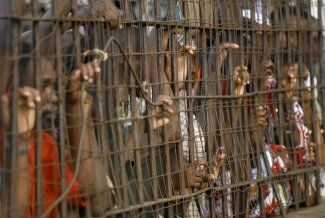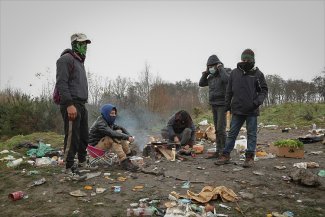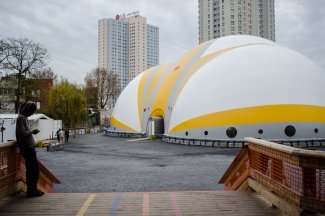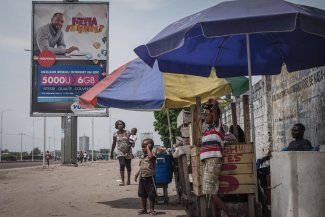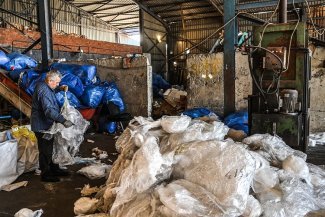
The vast majority of the inhabitants of Mayotte’s Miréréni neighbourhood are undocumented migrants from the Comoros islands, which means they are banned from working. This young man repairs cars to earn about €20 a day.
Bulldozers, mechanical diggers and a plume of smoke. There is an air of déjà vu in the images broadcast by the television channel Mayotte la 1ère at the beginning of July, during a report on the demolition of the Miréréni neighbourhood in Majicavo Koropa, a village in the north of this French island department, located between Mozambique and Madagascar. This is the sixth operation of its kind since the start of 2021. It is part of “the fight against illegal immigration and public insecurity in Mayotte in order to restore the rule of law and bring social peace,” according to a press release from the Mayotte prefecture.
Mayotte became a French department in 2011, having previously been an administrative division of the Comoros before the country’s independence in 1975. The department has a large Comorian population, that have fled the dictatorship and difficult living conditions of the archipelago, ranked among the poorest countries in the world. As a result, in 2019 Mayotte accounted for more than half of foreign expulsions from French territory, totalling around 27,000 people. Charities regularly denounce abusive practices and hasty evictions.
In recent months, the destruction of poor housing has become a major focus of state policy on the island. In an interview published on 18 May 2021 by the local newspaper Mayotte Hebdo, Jérôme Millet, the sub-prefect in charge of the portfolio describes it as “a priority”. The prefecture says it is taking this action to reclaim the land – there is little available in Mayotte – to improve people’s safety, because these informal settlements are built on dangerous land, and “to restore the rule of law”, in neighbourhoods described as “a refuge for troublemakers” by the sub-prefect in charge of the fight against poverty.
Since the beginning of the year, the prefecture has destroyed nearly 1,000 bangas, the tin huts that dot the territory. Its action is made possible thanks to on an amendment to the Elan law. This text, passed in 2018, allows the prefects of Mayotte and Guyana (French Guiana) to destroy homes deemed unhealthy more easily than elsewhere, on condition that they offer to rehouse those concerned. But in Mayotte, the social rental stock of around 300 units falls far short of what is needed.
Discarded like “unwanted objects”
Even before the Majicavo operation, mechanical diggers were being put to use in Miréréni. Between 250 and 350 people lived in the informal settlement of this western district of Grande-Terre, the larger of the two islands that make up the department. Two neighbourhoods were destroyed, with plans to replace them with a football field. The first, that of ‘the French’, was mostly made of solid houses. The second, nicknamed the ‘foreigners’ quarter’, mainly inhabited by Comorians from the island of Anjouan, was the poorer of the two.
Built on a slope, these makeshift homes are built without windows, and with no access to running water and electricity. To wash, you have to go down to the river, a few hundred metres below, where the water is covered, in places, with a whitish layer, and full of waste.
The inhabitants of this desperately poor neighbourhood were warned of their eviction a month in advance, via a prefectural decree.
A few days before their bangas were demolished in May, many people were still living there. This was the case with Zouliaty Halifa Bakany. With her grey hair, and a salouva – the traditional dress of Mayotte – tied around her waist, this fifty-something woman from Anjouan, the Comorian island closest to Mayotte, described a feeling shared by many of the inhabitants questioned: “I am like a discarded object. I have nowhere to go. I have lived here since 2014, and in Mayotte for 27 years. I don’t know what to do. When the machines arrive, I’ll stand in front of the house and watch my possessions being destroyed.”
She was offered emergency accommodation for a few weeks by the ACFAV, the departmental association for the condition of women, in charge of the social investigation. She refused: “I have one little girl who goes to primary school, another to high school. The accommodation they offered me is too far away.” Not everyone has been given this opportunity. In Miréréni, the ACFAV inspected only 111 people, including 47 adults. Sixty-two of them reportedly accepted temporary accommodation which they were able to occupy for a few weeks.
Journalists prevented from covering demolitions
Halifa Bakany has no papers and is wary of the border police (PAF), who came several times before the demolition. The prefecture decided to take advantage of the bulldozing operation to “get in early by carrying out operations on site and questioning them [Editor’s note: foreigners in an irregular situation], before taking them to the administrative detention centre,” as Millet underlines in Mayotte Hebdo. As a result of this policy, many men took refuge in the countryside rather than in their bangas.
A few hours before Halifa Bakany spoke out, the PAF took away around 15 people, sometimes leaving only children like Abdoullah, who is 14 years old. Dazed, he has just learned that his mother has been arrested by the police. “I was told that the PAF came into our home. That they took my mother. I was not there. Now I will surely go and live with my father, but I don’t know where he is.” The broken-down doors of some of the houses bear witness to the police visits.
The bulldozers arrive a week later. Nothing remains of the two neighbourhoods except the sheet metal piled up on the ground. Workers sort through the waste, a cloud of smoke envelops the entire area, and gendarmes watch who comes and goes. It is difficult for journalists to reach the site.
“Preventing journalists from getting in is a practice that is repeated more and more often,” says a local reporter, who wishes to remain anonymous.
He notably covered the demolitions of the district of Cétam, on Petite-Terre, the second inhabited island of the department. He remembers being prevented from working by the authorities. “Only Mayotte la 1ère and Kwezi TV [the two local television channels] were authorised to film the demolitions for a few minutes. They were ordered not to ask questions of the displaced inhabitants. I had to go through the thickets, because a police officer forbade me to enter the site. I was told it was for my own safety, but there were kids all over the rubble.”
In Miréréni, Rououyati skipped school to return to collect some of her family’s belongings during the demolition, against her mother’s advice. She didn’t want her to witness the destruction of her house for the second time. The first demolition took place in 2014, in the same town. The 18-year-old French girl regrets not having been able to save everything. She says: “There were gendarmes everywhere. They were circling the area and grabbing people who had no papers. Even people who were collecting their belongings. I stayed there, waiting for the workers to leave. After that, I went to see what was left, but there was nothing. I was only able to collect clothes, and a few notebooks.”
The experience has left her with bad memories. “I feel sad, like I am worth nothing. I cried with all the teenage girls who were there.”
Shortage of rented housing stock
Rououyati now lives in the south of the island, with family, but not everyone was able to do that. Her parents rebuilt a banga in the countryside. Some families slept for more than a month on mattresses on the ground, in more remote places, including some with young children who are forced to walk for several tens of minutes before joining the road that takes them to school.
These repeated expulsions worry members of the voluntary sector. Through the voice of its project manager, Pauline le Liard, the Cimade, an association for the defence of rights, regrets that the narrative focuses, above all, on delinquency. “There are families, people, in an irregular situation, but there are also a lot of French people and people who are legally registered. We have to stop pretending that it’s just a bunch of delinquents,” the young woman insists.
She is also angry about “the absence of decent, sustainable rehousing solutions, individually adapted to the families concerned.” The issue is one being looked at by Lucas Teiller, a geographer whose thesis focuses on public action over inadequate housing in Mayotte and the Paris region.
“I spoke with people in the accommodation sector who told me that they are constantly stretched, there are between 0 and 10 places available per day.”
However, thousands have been affected by the demolitions however, so the state is looking for alternative solutions. “On the one hand, the prefecture takes advantage of irregular situations to skim off part of the inhabitants of the neighbourhoods. The argument is that people are not meant to stay in the territory. Because it knows that there are not enough housing places, the prefecture encourages people to find solutions on their own. People in Cetam told me they got calls every day from ACFAV to ask them if they had found solutions. It’s not illegal, but in my opinion there is a moral problem,” says Le Liard.
Projects have been set up to counter the lack of available housing in the territory. Like that of the HARAPPA agency, which wants to build between 1,000 and 1,500 low-cost homes per year after setting up a first project of 30 homes in Koungou, in the north of the island. “But it’s not easy, and it takes time,” admits Attila Chayssial, the agency’s co-director.
Families who are not rehoused move to other areas of the island, as Teiller observes: “Destroying neighbourhoods is not a lasting solution. People will set up bangas a few kilometres from where they are evacuated.”
Once displaced, families are weakened. “Social and solidarity networks disappear when they move. They find themselves isolated, in hastily built houses without water, windows or electricity,” observes Lucas Teiller. “The real objective of the Elan law, in my opinion, is to put in place repressive tools, and to allow the prefecture to present itself as taking an effective stand against delinquency. If its goal were to save dignity, we would wait until we had a housing stock before demolishing homes.”



